Extra information
The problem of tortoise-shell nails (calcification) and athlete's foot indicates that microbial infections are not limited to horse's hooves.
 Clearly, the increased occurrence and spread of these infections are caused by contamination between animals and humans, vice versa. With people athlete's foot and calcified nails are in first instance the result of a fungal infection. If these complaints are not dealt with in time, there is a good chance that they will attract an additional bacterial infection. Bacterial infections can be simply recognized by their pungent smell. This situation develops as follows: first the fungal infection damages the horn and creates an oxygen-poor situation which then forms a good environment for anaerobic bacteria.
Clearly, the increased occurrence and spread of these infections are caused by contamination between animals and humans, vice versa. With people athlete's foot and calcified nails are in first instance the result of a fungal infection. If these complaints are not dealt with in time, there is a good chance that they will attract an additional bacterial infection. Bacterial infections can be simply recognized by their pungent smell. This situation develops as follows: first the fungal infection damages the horn and creates an oxygen-poor situation which then forms a good environment for anaerobic bacteria.
Horn of the skin
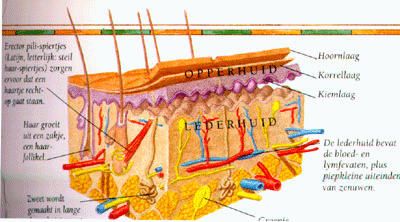 The skin has two layers, epidermis and cutis. The epidermis consists of keratinized, multiple-layered epithelium. The cells of the epithelium are called keratinocytes as they produce keratin (horny material). The cells on the surface of the epidermis are keratinized. This means that these are old cells which no longer have a nucleus or organelles (mortified organic material). The process develops just the same in people's nails as in the horse's hooves.Ţ
The skin has two layers, epidermis and cutis. The epidermis consists of keratinized, multiple-layered epithelium. The cells of the epithelium are called keratinocytes as they produce keratin (horny material). The cells on the surface of the epidermis are keratinized. This means that these are old cells which no longer have a nucleus or organelles (mortified organic material). The process develops just the same in people's nails as in the horse's hooves.Ţ
Micro-organisms
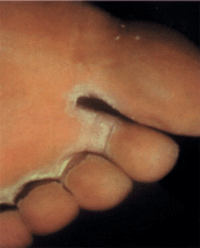 Fungi and bacteria can fix themselves on the keratin cells of which epidermis and nails consist. The fungi and bacteria then decompose the keratin and can multiply in this environment.
Fungi and bacteria can fix themselves on the keratin cells of which epidermis and nails consist. The fungi and bacteria then decompose the keratin and can multiply in this environment.
Micro-organisms have a function
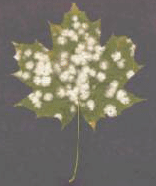 Micro-organisms occur plentiful in nature and their task is to decompose organic material. With horses you find such mortified organic material for instance in the straw, hay and manure in the stable. This sounds alright, but there is a snag. Because horny material is also mortified organic material, the micro-organisms like to decompose this as well.
Micro-organisms occur plentiful in nature and their task is to decompose organic material. With horses you find such mortified organic material for instance in the straw, hay and manure in the stable. This sounds alright, but there is a snag. Because horny material is also mortified organic material, the micro-organisms like to decompose this as well.
Where do micro-organisms live?
Given the chance, micro-organisms would live everywhere on earth, wherever they find the right conditions for survival. In fact, micro-organisms are the most serious competitors of man and animal on earth.
Conditions for mutliplication
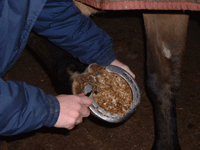 Once settled in a suitable environment, micro-organisms can multiply very fast. Nutrients, moisture, temperature (and oxygen) are crucial factors for the intensity of their growth and multiplication. In favourable conditions, such a warm, moist and oxygen-poor environment, fungi and bacteria will develop and cause damage.
Once settled in a suitable environment, micro-organisms can multiply very fast. Nutrients, moisture, temperature (and oxygen) are crucial factors for the intensity of their growth and multiplication. In favourable conditions, such a warm, moist and oxygen-poor environment, fungi and bacteria will develop and cause damage.
The hoof as a suitable environment
Particularly the area between the shoe and the hoof and all places where manure will stick to the hoof offer favourable conditions for these micro-organisms. The same applies to old nail-holes or damage to the hoof. In these cases fungi and anaerobic bacteria may even attack simultaneously.
How fast do micro-organisms multiply?
Given a constantly sufficient supply of nutrients and moisture in combination with suitable temperatures and oxygen-level, the following rate of multiplication will be found:
Ana╬robe bacteri╬n (6000 x vergroot)
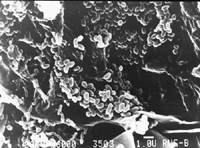 The fission (cell division) time for bacteria is about 10 minutes. Bacteria grow by simply splitting in two (binary fission) once the hereditary material has been doubled. Therefore, theoretically, after 48 hours a single bacterial cell can have developed a series of descendants (so-called bacterial colony) of 2 to the force (6 x 48) = 5 x 1087 which would represent a mass the size of about 8,000 x the mass of the earth! However, if such explosive growth would occur, one or more of the growing factors will get soon depleted and slow down the fission time. As conditions get worse for the bacteria, they will soon decrease in numbers, but never entirely disappear. As soon as the environment improves again, multiplication will be resumed at the highest possible rate.
The fission (cell division) time for bacteria is about 10 minutes. Bacteria grow by simply splitting in two (binary fission) once the hereditary material has been doubled. Therefore, theoretically, after 48 hours a single bacterial cell can have developed a series of descendants (so-called bacterial colony) of 2 to the force (6 x 48) = 5 x 1087 which would represent a mass the size of about 8,000 x the mass of the earth! However, if such explosive growth would occur, one or more of the growing factors will get soon depleted and slow down the fission time. As conditions get worse for the bacteria, they will soon decrease in numbers, but never entirely disappear. As soon as the environment improves again, multiplication will be resumed at the highest possible rate.
Schimmel scopulariopsis brevicaulis (600 x vergroot)
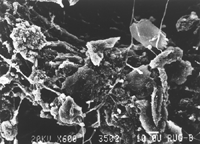 Fungi, with a slower rate of growth than bacteria, normally take 2 to 3 weeks to fully develop and to form spores. However, if certain fungi which thrive on horny material can settle in a horny environment, the rate of growing and formation of spores will accelerate considerably. Once fungi have developed, they are more harmful than bacteria, specifically in a nutrient-poor environment, because that is when fungi will start producing a lot of highly noxious material!!! Also, the spores of fungi can survive for a very long time in a dried condition, after which, when the environment had improved again, they can produce new fungi within 2 to 3 hours.
Fungi, with a slower rate of growth than bacteria, normally take 2 to 3 weeks to fully develop and to form spores. However, if certain fungi which thrive on horny material can settle in a horny environment, the rate of growing and formation of spores will accelerate considerably. Once fungi have developed, they are more harmful than bacteria, specifically in a nutrient-poor environment, because that is when fungi will start producing a lot of highly noxious material!!! Also, the spores of fungi can survive for a very long time in a dried condition, after which, when the environment had improved again, they can produce new fungi within 2 to 3 hours.
When does a horse develop an infection?
An infection will only develop when the hoof is contaminated by micro-organisms in such a quantity that the micro-organisms can grow into the hoof.Therefore the balance between hoof growth and amount of micro-organisms present is very delicate. Once micro-organisms manage to grow into the horn faster than the hoof is able to produce new horn material, you get a problem (infection).
Protective system
Only when the growing conditions are expertly manipulated and controlled, will man and animal be free from harmful, pathogenic micro-organisms, for as long as it lasts. In this way, the risks can be limited to a minimum.
The horse's hoof must be protected:
1. Against urine
2. Against micro-organisms
3. Against drying out
Enamel
The hoof is only protected by the outer layer of the horny wall. The horny wall consists of limbus cornea ungulae (seam) and stratum tectorium (enamel layer) and its function is to regulate the fluid balance. Naturally, the protective system of the hoof also depends on the quality of the horn itself.
Instinct of the horse
The hoof is little protected against micro-organisms and the harmful acids in urine. Nature has bestowed the horses with the instinct to protect themselves against harmful conditions by avoiding places with intensive urine. This explains why a horse will never graze on (the former location of) droppings and why it carefully avoids soiling itself when urinating. Clearly, the way we are keeping horses 'boxed up' is unnatural. The horse's hooves cannot avoid intensive contact with harmful elements and this further undermines the immune system.
Horse shoes
The problem gets more complicated when the horse is shod, because the space between shoe and hoof is moist most of the time. Mucking out every day is not enough to prevent this problem. The fact that we have to clean the hooves every day confirms that we expose the horse to the focus of infection, namely direct contact with these micro-organisms. And we present them the horn of the hoof on a platter!
The quality of the horn material
The structure of the horn determines the quality of the horn. This is also influenced by heredity, health (stress), functioning of the hoof mechanism and fluid balance.
The structure of the horn material
The coarser the structure of the horn material, the more brittle and weaker will the hoof, which will therefore more easily be decomposed by micro-organisms. Obviously, the white line - the coarsest and most open structure, and therefore the weakest part of the hoof - is most easily affected by micro-organisms.
Horn growth
Hooves that grow fast are not stronger but have a coarser horn structure and are therefore weaker than hooves displaying slower (normal) growth. A hoof with horn material with a fine structure will be harder and stronger, but here the proper fluid balance becomes important. These hooves may be stronger but will more easily crack when they get too dry. It is the same with wood; the way different types of wood grow determines their quality: the faster it grows, the weaker the wood.
Fluid balance
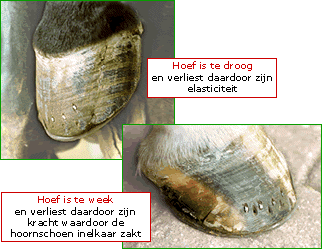 Great fluctuations in the fluid level in the hoof have a negative effect on the quality of the horn. The enamel contains the fluid supplied by the body and also prevents moisture penetrating the hoof from the outside. When all is well, this will ensure a proper fluid balance in the hoof. This is important for the elasticity (shock-absorbing capacity), optimum strength and functionality of the hoof mechanism.
Great fluctuations in the fluid level in the hoof have a negative effect on the quality of the horn. The enamel contains the fluid supplied by the body and also prevents moisture penetrating the hoof from the outside. When all is well, this will ensure a proper fluid balance in the hoof. This is important for the elasticity (shock-absorbing capacity), optimum strength and functionality of the hoof mechanism.
Parts of the hoof
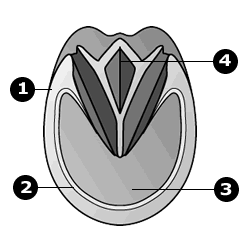 The four components are connected and together form an essential part of the hoof. If one or more are affected by micro-organisms, this will negatively influence the functionality (protection and circulation) of the horse's feet. To much strain on the sole is also an impediment for proper circulation. The more the hoof is affected, the more its functionality is impaired and the faster it will deteriorate.
The four components are connected and together form an essential part of the hoof. If one or more are affected by micro-organisms, this will negatively influence the functionality (protection and circulation) of the horse's feet. To much strain on the sole is also an impediment for proper circulation. The more the hoof is affected, the more its functionality is impaired and the faster it will deteriorate.
Circulation in the feet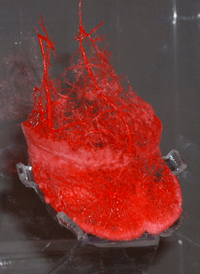
The condition of the hoof determines the functionality of the feet.
When the hoof is in good condition, it is strong and elastic and ensures the cohesion of the various components of the hoof. This allows optimum and regular expansion of the hoof when it is put down and smooth contraction of the hoof when lifted.
Seven weeks later. This produces optimum circulation in the hoof, regular growth and quality of the horn and therefore a strong hoof.
With RWL QUALITY micro-organisms can be manipulated so skillfully that deterioration will be stopped, while the quality of the horn is improved at the same time, after which the hoof can recover and function normally.
The manner of treatment depends on the different components of the hoof, related to differences in horn structure and susceptibility to disease.
After 5 years of comprehensive study by RWL Quality and research performed by the State University of Groningen, RWL Quality has developed several products with the assistance of scientists G. Stulen, doctor of chemistry and P.S. Soentpiet, biochemic Research & Development.